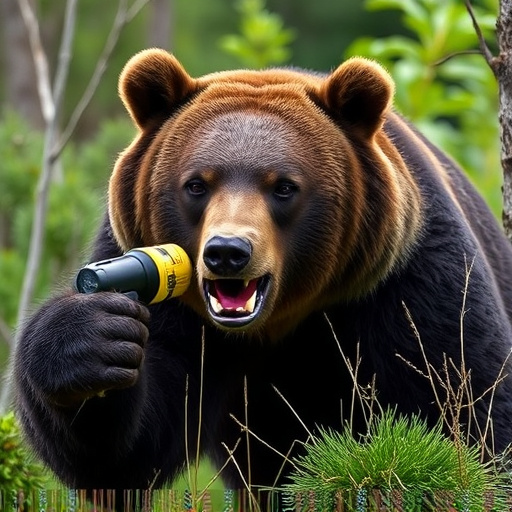Bear spray, an essential tool in bear country, deters aggressive encounters by spraying capsaicin into a bear's face, effective up to 35 feet. Though not considered a restricted weapon, its use is heavily regulated due to potential side effects. Selection should focus on larger cans, higher pressure ratings, and active ingredients like capsaicin or UVa light. Proper usage requires training and understanding manufacturer instructions. Effectiveness varies by bear species and local regulations regarding permits and quantity limits must be understood.
“Bears can be unpredictable, making bear deterrent spray a vital tool for outdoor enthusiasts and those living in bear country. This comprehensive guide explores the ins and outs of bear spray, focusing on its effectiveness, legal status as a restricted weapon, and how to choose the best option for maximum range protection. Understanding these key aspects ensures safety when venturing into areas with bear populations. Learn what sets different brands apart and discover the factors critical to repelling bears effectively.”
- Understanding Bear Spray: The Basics and Its Effectiveness
- Legal Considerations: Is Bear Spray a Restricted Weapon?
- Choosing the Right Bear Deterrent Spray for Maximum Range Protection
Understanding Bear Spray: The Basics and Its Effectiveness
Bear spray, also known as bear deterrent spray or pepper spray for bears, is a specialized product designed to protect individuals from aggressive bear encounters in wild environments. It’s not considered a restricted weapon but rather an essential tool for outdoor enthusiasts and those living in bear country. The primary active ingredient in bear spray is capsaicin, the same compound that gives chili peppers their heat. When sprayed towards a bear’s face, eyes, and nose, capsaicin irritates these sensitive areas, causing the bear to recoil and temporarily disable itself.
The effectiveness of bear spray lies in its ability to create enough distance between the user and the bear for safe escape. The maximum range varies by product but typically falls between 20 to 35 feet (6 to 10 meters). It’s crucial to understand that bear spray is not a permanent solution or a substitute for proper bear safety measures, such as making noise while hiking, avoiding known bear habitats, and properly storing food. Despite its reliability in deterring most bears, it may not work on every encounter, especially with certain species like brown bears and black bears, which can have varying behaviors and tolerances to capsaicin.
Legal Considerations: Is Bear Spray a Restricted Weapon?
In many regions, bear deterrents, particularly spray, are subject to strict regulations due to their potent nature and potential impact on both wildlife and humans. The classification of bear spray as a restricted weapon varies widely depending on location. In some areas, it’s considered an offensive weapon, while others view it more as a self-defense tool. This legal variability often hinges on factors such as the spray’s capsaicin concentration and the jurisdiction’s specific laws regarding personal protection equipment.
Carrying bear spray can have significant implications, with certain locations mandating permits or limiting the quantities one can possess. It’s crucial for users to understand local regulations to ensure compliance and safety. Knowing whether bear spray is classified as a restricted weapon in your area is essential before considering it as a bear deterrent option.
Choosing the Right Bear Deterrent Spray for Maximum Range Protection
When selecting a bear deterrent spray, understanding its range and effectiveness is paramount for ensuring maximum protection in bear country. Not all bear sprays are created equal; factors like can size, pressure, and active ingredients greatly impact the distance it can reach and deter an attacking bear. For optimal range, look for sprays with larger cans and higher pressure ratings, as these deliver a more powerful stream and cover a wider area.
It’s also crucial to consider the type of active ingredient used. Common components like capsaicin (the “heat” in chili peppers) or UVa light disrupt a bear’s sensory perception, triggering an escape response. Some sprays even combine multiple ingredients for enhanced deterrence. While not considered a restricted weapon, proper usage requires training and understanding; always follow manufacturer instructions to ensure safety and effectiveness.
Bear spray has proven to be an effective deterrent, but understanding its range and legal status is crucial. While it’s not a restricted weapon in many areas, knowing the specific regulations is essential for responsible usage. Choosing the right bear deterrent spray with maximum range protection can significantly enhance safety during outdoor activities in bear country. Always opt for high-quality products that meet industry standards to ensure their effectiveness when needed.
